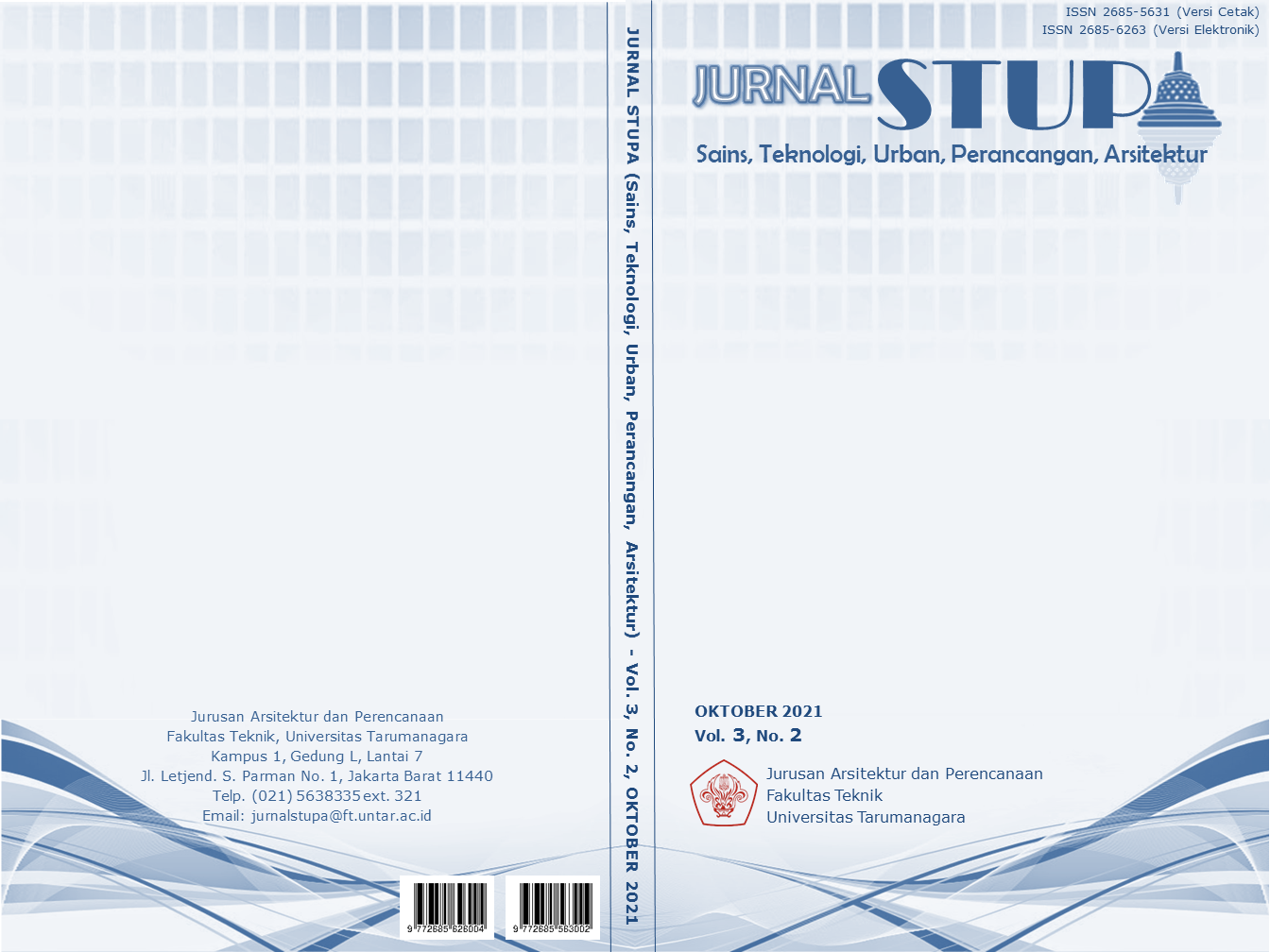PABRIK GASIFIKASI BERBASIS EDUKASI DAN REKREASI AIR SEBAGAI SOLUSI PENCEMARAN SAMPAH PLASTIK SUNGAI CITARUM KABUPATEN BANDUNG
Main Article Content
Abstract
The existence of plastic waste can be equated as a malignant cancer that’s more and more invading and destroy the life that is on earth. Indonesia itself is the second largest producer of plastic waste in the world. Indonesia’s efforts in dealing with this matter are still not optimal. Combination between people lack of awareness and lack of waste management create plastic issue as a main problem that threatened the entire country’s ecosystem. Citarum river as an ancient river that has been a source for the people for thousands of years has begun to collapse and even makes an impact on other ecosystems. Rule – making or simply waste collecting is not part of architects job, but with the design skills that we have, we can build a place for processing, educating, socializing or even recreation. The project with the name Lahir Alir Hilir as Gasification Plant and Recreational Space is here to meet these needs as a place. By fulfilling the six ecological parameters as well as using contextual method as an approach, Lahir Alir Hilir project can become an example or solution in solving plastic waste issue in Indonesia.
Keywords: Gasification plant; Waste management; Plastic waste
Abstrak
Eksistensi sampah plastik dapat diibaratkan seperti kanker ganas yang semakin lama akan menginvasi dan menghancurkan seluruh kehidupan di bumi. Indonesia sendiri merupakan negara penghasil sampah plastik terbesar nomor dua di dunia. Upaya Indonesia dalam menangani masalah tersebut masih belum optimal. Kombinasi antara kurangnya kesadaran masyarakat dan manajemen sampah menjadikan sampah plastik sebagai permasalahan utama yang mengancam keseluruhan ekosistem Indonesia. Sungai Citarum sebagai sungai purba yang menjadi sumber kebutuhan orang-orang selama ribuan tahun pun mulai lumpuh dan justru memberikan dampak buruk bagi ekosistem lainnya. Menciptakan peraturan ataupun sekedar mengumpulkan sampah bukan menjadi tugas seorang arsitek, namun dengan kemampuan desain yang kita miliki, kita dapat membangun sebuah wadah sebagai tempat pengolahan, edukasi, sosialisasi maupun rekreasi. Proyek dengan nama Lahir Alir Hilir sebagai Pabrik Gasifikasi dan Rekreasi hadir untuk memenuhi kebutuhan-kebutuhan tersebut sebagai wadah. Dengan memenuhi enam parameter ekologi dan juga pendekatan dengan metode kontekstual menjadikan proyek Lahir Alir Hilir sebagai contoh atau salah satu solusi bagi penyelesaian permasalahan utama sampah plastik di Indonesia.
Article Details
References
Andersen, K. (Producer) 2021. Seaspiracy. Netflix. 89 menit.
Brolin, B. C. (1980). Architecture in Context: Fitting New Buildings with Olds. Van Nostrand Reinhold Company: Inggris.
Gershman, B. & Bratton, Inc. (2013). Gasification of Non-Recycled Plastics From Municipal Solid Waste In the United States. Diakses 8 Agustus 2021, dari https://plastics.americanchemistry.com/Sustainability-Recycling/Energy-Recovery/Gasification-of-Non-Recycled-Plastics-from-Municipal-Solid-Waste-in-the-United-States.pdf
Gershman, B. & Bratton, Inc. (2013). Gasification of Non-Recycled Plastics From Municipal Solid Waste In the United States. Diakses 8 Agustus 2021, dari https://plastics.americanchemistry.com/Education-Resources/Publications/The-Evolution-of-Mixed-Waste-Processing-Facilities-Technology-and-Equipment-Guide.pdf
Ichzani, M. F. (2018). Waste to Energy, Jatibarang. (Tugas Akhir Sarjana, Universitas Dipenogoro, 2018). Diakses 26 Juni 2021, dari http://eprints.undip.ac.id/70090/
Lyu, Y. (2019). Biomass sources in Parkstad – Research on conditions as a renewable energy. (Master Thesis, Faculty of Architecture & the Built Environment, Delft University of Technology, 2015). Diakses 6 Agustus 2021, dari https://repository.tudelft.nl/islandora/object/uuid:399229ac-93d7-4255-87cf-5c8d4e2bae26.
Mcdonough, W dan Michael B. (2002). Cradle to Cradle. New York: North Point Press.
Muller, J. A. (2016). The Architecture of Waste - Creating New Avenues for Public Engagement with Trash. (Master of Architecture Thesis, University of Maryland, 2016) Diakses 27 Juni 2021, dari https://drum.lib.umd.edu.
Sundar, S. (2017). Eco-Centre, Mumbai. (Undergraduate Program Thesis, School of Planning and Architecture, New Delhi, 2017). Diakses 26 Juni 2021, dari https://issuu.com/shwetasundar2/docs/report_done
Tam, Kim-Pong. (2020). Gratitude to Nature: Presenting a Theory of its Conceptualization, Measurement, and Effects on Pro-Environmental Behavior. Diakses 27 Juni 2021, dari https://www.researchgate.net/publication/347761651_Gratitude_to_Nature_Presenting_a_Theory_of_its_Conceptualization_Measurement_and_Effects_on_Pro-Environmental_Behavior.
Wijayanti, D R dan Sri S. (2015). Waste Bank as Community-based Environmental Governance: A Lesson Learned from Surabaya. Procedia - Social and Behavioral Sciences 184 (2015) 171 – 179.
World Bank Technical Guidance Report. (1999). Municipal Solid Waste Incineration. Washington D.C. : The World Bank.


